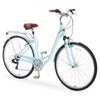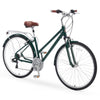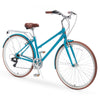How to Shift Gears on a 7 Speed Adult Tricycle | When You Should Shift Gears
Video Blog
June
02, 2021
How to Shift Gears on a 7 Speed Adult Tricycle When You Should Shift Gears
Copy Link
http://www.sixthreezero.com/blogs/bike-advice/how-to-shift-gears-on-a-7-speed-adult-tricycle-when-you-should-shift-gears
Hi, it's Alanna here with Sixthreezero. Today, I'm going to show you how to shift on a tricycle, and I'll give you some tips on when you should be shifting.
When it comes to shifting gears, there are a few things that you want to remember. The first is that you should not shift gears while you are at a stop. You always want to make sure you're moving when you shift gears. Another thing is that you should only shift one gear at a time. Do not try to skip ahead from four to six, take them one at a time. And shift gears, you're just going to grip the gear shifter, here, and you shift away from you to go to a higher gear and twist it toward you to go to a lower gear.
You can see on the dial, here, what gear you're in, and it has a plus and minus sign, so you know which direction will increase or decrease your gear.
Make sure that when you're shifting gears, you only shift one gear at a time. Don't jump from four to six. You want to take it from four to five, then from five to six, but don't jump ahead. Another thing to know is that you should not try to shift gears while pedaling too aggressively. If you are pedaling really aggressively and you try to shift gears, then you'll hear a grinding noise, and the bike might not even shift. What you want to actually do is pedal softly and slowly. Actually, you can just hold off, pause for one stroke, the bike will still be moving, but you just won't be pedaling for one stroke, and at the same time that is you will twist the gear shifter.
Getting used to shifting gears takes practice. So, if you can, find a large empty parking lot that you can practice biking in, and just working from the highest gear down to the lowest gear and back. A higher gear corresponds to higher effort from you when pedaling, and a lower gear means lower effort while pedaling, so it's going to be a lot easier to get moving.
Now, when to shift gears? Well, when approaching a hill, that is a good time to shift gears, and you're going to want to shift to a lower gear. The hill is going to add resistance, so if you stay at the same gear, it's going to feel a lot harder to pedal. By shifting to a lower gear, you can maintain your pedaling cadence and maintain your perceived effort as you go up the hill. That way, you won't have to stop midway, if you get too tired and then walk your trike up. This way, you can work your way all the way up through the hill without stopping, and then you can go ahead and adjust your gears.
One thing to consider with the shifting gears is that you can always go up. I would recommend starting low, seeing how that feels. If it feels too easy, then you can increase your gear from there. Another time when you'll want to shift gears is when you have wind resistance. Wind resistance is also going to slow you down and make you feel like you're using more effort, so you can counter that by, again, shifting to a lower gear, so you can maintain your consistent pedaling cadence.
Also, when approaching a turn or a stop, you will want to, probably, shift to a lower gear. With a turn, you want to slow down as you enter the turn, but then you'll want to pick up speed as you exit the turn. In order to quickly pick up speed, you want to make it as easy for you as possible to pedal, and you do that by shifting to a lower gear. The same with a stop. After a stop, you're going to need to quickly get back into movement, so to do that you want to make sure you're in a lower gear so that you can easily pedal out of your stop.
Like I said earlier, you always want to make sure that you're looking up ahead to anticipate any sort of changes that you'll be encountering, like turns, hills, and stops. Another thing to consider is stretch on your knees. That's another reason why you will want to shift to a lower gear or start off in a lower gear, and then adjust from there. You do not want to put a lot of stress on your knees. A lot of us are riding bikes and trikes because it's a low-impact sport that doesn't put a lot of stress on your knees.
That's pretty much it. When in doubt, start off with a lower gear. That's going to make pedaling easy for you. It's going to make it easier for you to get through any obstacles you encounter. And as you build up strength in your legs, you can play around with higher gears. Hopefully, that helps you out, and you'll be better equipped to know when to shift gears, and how to shift gears so that you can get out there on your trike. If you have any trike questions or any topics that you want us to cover, please let us know in the comments below. Thank you so much for watching. It's your journey, your experience, enjoy the ride.
When it comes to shifting gears, there are a few things that you want to remember. The first is that you should not shift gears while you are at a stop. You always want to make sure you're moving when you shift gears. Another thing is that you should only shift one gear at a time. Do not try to skip ahead from four to six, take them one at a time. And shift gears, you're just going to grip the gear shifter, here, and you shift away from you to go to a higher gear and twist it toward you to go to a lower gear.
You can see on the dial, here, what gear you're in, and it has a plus and minus sign, so you know which direction will increase or decrease your gear.
Make sure that when you're shifting gears, you only shift one gear at a time. Don't jump from four to six. You want to take it from four to five, then from five to six, but don't jump ahead. Another thing to know is that you should not try to shift gears while pedaling too aggressively. If you are pedaling really aggressively and you try to shift gears, then you'll hear a grinding noise, and the bike might not even shift. What you want to actually do is pedal softly and slowly. Actually, you can just hold off, pause for one stroke, the bike will still be moving, but you just won't be pedaling for one stroke, and at the same time that is you will twist the gear shifter.
Getting used to shifting gears takes practice. So, if you can, find a large empty parking lot that you can practice biking in, and just working from the highest gear down to the lowest gear and back. A higher gear corresponds to higher effort from you when pedaling, and a lower gear means lower effort while pedaling, so it's going to be a lot easier to get moving.
Now, when to shift gears? Well, when approaching a hill, that is a good time to shift gears, and you're going to want to shift to a lower gear. The hill is going to add resistance, so if you stay at the same gear, it's going to feel a lot harder to pedal. By shifting to a lower gear, you can maintain your pedaling cadence and maintain your perceived effort as you go up the hill. That way, you won't have to stop midway, if you get too tired and then walk your trike up. This way, you can work your way all the way up through the hill without stopping, and then you can go ahead and adjust your gears.
One thing to consider with the shifting gears is that you can always go up. I would recommend starting low, seeing how that feels. If it feels too easy, then you can increase your gear from there. Another time when you'll want to shift gears is when you have wind resistance. Wind resistance is also going to slow you down and make you feel like you're using more effort, so you can counter that by, again, shifting to a lower gear, so you can maintain your consistent pedaling cadence.
Also, when approaching a turn or a stop, you will want to, probably, shift to a lower gear. With a turn, you want to slow down as you enter the turn, but then you'll want to pick up speed as you exit the turn. In order to quickly pick up speed, you want to make it as easy for you as possible to pedal, and you do that by shifting to a lower gear. The same with a stop. After a stop, you're going to need to quickly get back into movement, so to do that you want to make sure you're in a lower gear so that you can easily pedal out of your stop.
Like I said earlier, you always want to make sure that you're looking up ahead to anticipate any sort of changes that you'll be encountering, like turns, hills, and stops. Another thing to consider is stretch on your knees. That's another reason why you will want to shift to a lower gear or start off in a lower gear, and then adjust from there. You do not want to put a lot of stress on your knees. A lot of us are riding bikes and trikes because it's a low-impact sport that doesn't put a lot of stress on your knees.
That's pretty much it. When in doubt, start off with a lower gear. That's going to make pedaling easy for you. It's going to make it easier for you to get through any obstacles you encounter. And as you build up strength in your legs, you can play around with higher gears. Hopefully, that helps you out, and you'll be better equipped to know when to shift gears, and how to shift gears so that you can get out there on your trike. If you have any trike questions or any topics that you want us to cover, please let us know in the comments below. Thank you so much for watching. It's your journey, your experience, enjoy the ride.
Take our Free Body Fit Questionnaire
Similar Articles
2021 Best Electric Bikes for Short Riders
If you fall outside the average measurements of most folks, you know that sizing items are...
eBike
How to Bike Uphill - With & Without an Electric Bike
Getting started when biking uphill, it's going to be hard when you start off, especially if...
Video Blog
Bike Benefits How Biking Can Improve Your Fitness at All Ages
Now that spring is here, it's sunny, you definitely want to get that vitamin D and...













